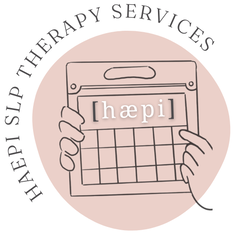|
I think this clip demonstrates a few things we really strive for at HAEPI SLP: following the child's lead, embracing all play, and modelling without expectation both on AAC and verbal phrases for gestalt language processors.
The @gestaltgoodness cards shown were also a great addition - my kiddo loved listening to the child model via the QR code. Usually I stay completely away from flash cards with GLPs, but these ones are designed for the communication partners (not necessarily the child), so WE can remember to model naturally in play, and use easily mitigable phrases across contexts. I also loved introducing the cards to school staff to further explain how we can model (!!!), because it takes a while to become natural for anyone new to GLP! *I received these First Phrases cards as a gift, with no expectation to review. Just love them that much!* by Halle Demchuk, SLPPaediatric SLP | GLP-Trained Clinician | Owner of HAEPI SLP
Qualification criteria is ableist, not evidence-based, and restricts access to the human right of communication for kids who need it the most.
Could you imagine what it would be like to tell a kindergarten-aged child, "looks like you can't hold a pencil, so that means you'll never be able to write. We may as well never let you have a pencil since you clearly can't use it." Do we all agree that's ridiculous? Yet, that's essentially what we are doing when we deny a child access to AAC systems because they aren't matching a picture or selecting an icon independently during the time of the AAC assessment. My hope for the future is that we can eliminate qualification criteria for funded AAC systems, so that we can get AAC into the hands of all children who need it. by Halle Demchuk, SLPPaediatric SLP | GLP-Trained Clinician | Owner of HAEPI SLP
To all Speech-Language Professionals: if you've ever wondered how you were going to model AAC to a child with a device during a virtual session, I hear you!
We know AAC is best modelled in natural environments and during play, and while most SLPs have figured out ways to do something resembling play-based therapy over Zoom, AAC can feel like a whole other ballgame. So, I wanted to show you one of my favourite resources to use: music videos and songs! This is completely free using YouTube. I'll sometimes do a Boom Deck first or something that teaches the target words (e.g., we learned "go" and "stop" in a Boom Deck game) and then follow that up with "singing" along to a song. I have an iPad Pro that I like to use for modelling as it's quite a bit bigger and therefore easier to see on Zoom while the video is playing. I also like to use this with "Head, Shoulders, Knees, and Toes" and "5 Little Ducks." Just because our kids may live in hard to reach places (like in remote Northern communities), this doesn't mean we can't still do play-based AAC virtually... we just need to be creative! by Halle Demchuk, SLPPaediatric SLP | GLP-Trained Clinician | Owner of HAEPI SLP
"I want" is a necessary phrase to know, but it's often drilled into our AAC users in a way that results in them learning that AAC is only for requesting and not for anything else, like negating or protesting.
In this post, I wanted to show how we can and should work on requesting while including protesting. I also wanted to illustrate that this can be worked on naturally, even with an AAC user virtually over Zoom! We played a Boom Cards game where we opened presents and decided if he wanted what was inside, or didn't want it. I also modelled other words throughout the game. I use an iPad Pro whenever I am modelling over Zoom because of its larger size (remember, his screen would be split to show me and the iPad on one half, and the game on the other). The takeaway: "I want" is still a useful and functional phrase, but it shouldn't be your sole focus. It should be introduced alongside a way to protest, too!
Check out a glimpse of Kaelyn's Music-Directed Speech Therapy session with a Stage 1 GLP and new AAC user!
Music is highly motivating for many gestalt language processors due to musical features like intonation and pitch. You'll notice how this child actually requested help when he gestured for Kaelyn to touch his device, which demonstrates how quickly he has learned the purpose of an AAC device for communication. Furthermore, watch how Kaelyn honours every mode of communication, whether it be speech, gestures, or AAC. This child also receives GLP-focused intervention with an SLP to expand his repertoire of Stage 1 gestalts. Lastly, we have the school to thank for letting us work in the sensory room, where this child can receive external sensory input to aid in regulation. We love a full team approach! by Halle Demchuk, SLPPaediatric SLP | GLP-Trained Clinician | Owner of HAEPI SLP |
The HAEPI BlogCheck here for HAEPI updates, helpful SLP information, free resources, articles, and more!
Archives
June 2024
Categories
All
|
Empowering Happy Communicators |
get in touch |
Quick Links |
© HAEPI SLP THERAPY SERVICES.
HAEPI SLP Therapy Services is proudly neurodiverse, Indigenous-owned, and woman-operated.
We acknowledge that the City of Thunder Bay has been built on the traditional territory of Fort William First Nation, signatory to the Robinson Superior Treaty of 1850. We also recognize the contributions made to our community by the Métis people. We strive as guests on these lands to honour our responsibilities to care for this land and uphold the Treaties that were signed therein.



